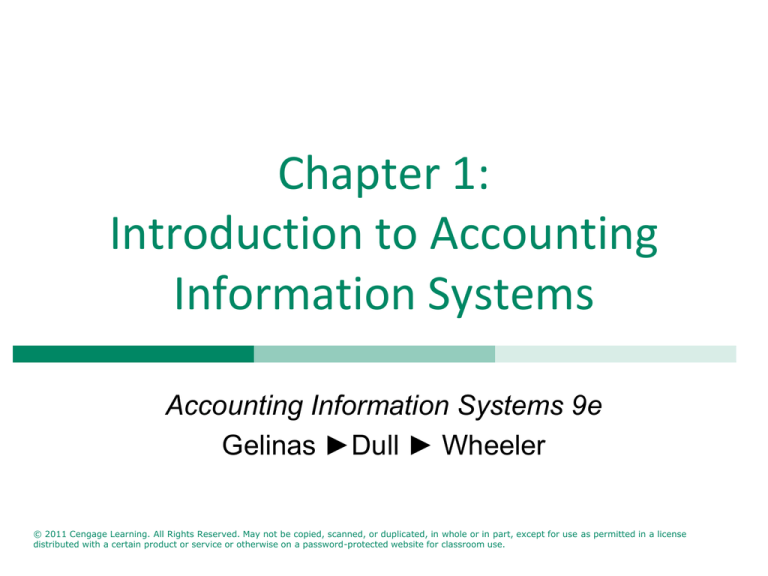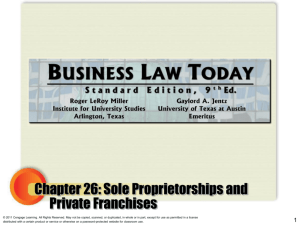
Chapter 1:
Introduction to Accounting
Information Systems
Accounting Information Systems 9e
Gelinas ►Dull ► Wheeler
© 2011 Cengage Learning. All Rights Reserved. May not be copied, scanned, or duplicated, in whole or in part, except for use as permitted in a license
distributed with a certain product or service or otherwise on a password-protected website for classroom use.
Learning Objectives
Appreciate the complex, dynamic environment
in which accounting is practiced.
Know the relationship between the AIS and the
organization’s business processes.
Know the attributes of information.
Recognize how information is used for different
types of decisions and at various levels in the
organization.
© 2011 Cengage Learning. All Rights Reserved. May not be copied, scanned, or duplicated, in whole or in part, except for use as permitted in a license
distributed with a certain product or service or otherwise on a password-protected website for classroom use.
Learning Objectives (cont’d)
Recognize how the information system supports
the management function.
Recognize the accountant’s role in relation to
the current environment for the AIS.
Understand how to use this textbook effectively
to learn AIS.
© 2011 Cengage Learning. All Rights Reserved. May not be copied, scanned, or duplicated, in whole or in part, except for use as permitted in a license
distributed with a certain product or service or otherwise on a password-protected website for classroom use.
Focus of the Course
Internal Control — a process to provide
reasonable assurance that organizational
objectives will be achieved.
Chapters 7 and beyond (8, 9, 11, 12, 13, 16)
© 2011 Cengage Learning. All Rights Reserved. May not be copied, scanned, or duplicated, in whole or in part, except for use as permitted in a license
distributed with a certain product or service or otherwise on a password-protected website for classroom use.
What is an Information System?
An Information System (IS) is interrelated
components to collect, process, store and
distribute information to support mainly
decision makings in an organization
Information technology (IT) describes the
combination of computer technology (hardware
and software) with telecommunications
technology (data, image, and voice networks).
CBIS vs. Manual IS
Data vs. Information
Data
refers to raw facts
Example: inventory part number or sales orders
Information
refers to data that have been processed and
presented in a form suitable for human
interpretation
Example: total number of registered students based
on each major or geographical purchasing pattern of
SUV
Example of data
Example of information
Why study AIS?
Information Age
Bill Gates (how much rich?), List of GDP
Major TANGIBLE product of Microsoft
Information age phenomena
Population of “facebook.com” : 800 million active user
US: 310 million
Accounting service
Software
Online
Example of why studying AIS
Sarbanes-Oxley Act of 2002
The Sarbanes-Oxley Act (SOX) mandated strict
reforms to improve financial disclosures from
corporations and prevent accounting fraud.
SOX was enacted in response to the accounting
scandals in the early 2000s.
Scandals such as Enron, Tyco, and WorldCom shook
investor confidence in financial statements and
required an overhaul of regulatory standards.
© 2011 Cengage Learning. All Rights Reserved. May not be copied, scanned, or duplicated, in whole or in part, except for use as permitted in a license
distributed with a certain product or service or otherwise on a password-protected website for classroom use.
WorldCom scandal
Fierce competitors to AT&T and Sprint
Used to have:
88,000 employees
60,000 miles of telephone lines around the world
Revenue of $40 billion
Collapsed because of the accounting fraud
$11 billion
One of the biggest (second: Lehman Brothers, ENRON)
A main trigger
Simple: failure of systems integration
Four different billing systems
© 2011 Cengage Learning. All Rights Reserved. May not be copied, scanned, or duplicated, in whole or in part, except for use as permitted in a license
distributed with a certain product or service or otherwise on a password-protected website for classroom use.
Sarbanes-Oxley Act of 2002
(cont’d)
Implications for both public and private
accountants:
Section 404 (as modified by PCAOB Auditing
Standard No. 5) –
Management must identify, document, and
evaluate significant internal controls.
Auditors must report on the effectiveness of
the organization’s system of internal controls.
© 2011 Cengage Learning. All Rights Reserved. May not be copied, scanned, or duplicated, in whole or in part, except for use as permitted in a license
distributed with a certain product or service or otherwise on a password-protected website for classroom use.
Sarbanes-Oxley Act of 2002
(cont’d)
Implications for both public and private
accountants:
Section 409 –
Requires disclosure to the public on a
“rapid and current” basis of material changes
in an organization’s financial condition.
None of sections possible w/o AIS
© 2011 Cengage Learning. All Rights Reserved. May not be copied, scanned, or duplicated, in whole or in part, except for use as permitted in a license
distributed with a certain product or service or otherwise on a password-protected website for classroom use.
More examples
Average American relies on more than 250
computers per day
More so in accounting
45 of the 2008 Fortune 500 companies were IT
companies
Dell Computer is one of them – it was started in
1984 and now has 65,000 employees worldwide
1-14
Downside of information age
$490 – credit card number and PIN
$147 – driver’s license number
$147 – birth certificate
$6 – PayPal logon and password
$78-$294 – billing data including account
number, address, birth date, etc
1-15
Type of Jobs based on
Type of Decisions-Makings
Better to have a job that complies with rules of
information age….
Structured
Small accounting book keepers and small
independent travel agencies
Routine & Repetitive
Problems are predictable
Problems can be solved by applying standard
solutions
Type of Jobs based on
Type of Decisions-Makings
Unstructured
Accounting consultant
Non-routine, Unpredictable, and Fuzzy
Standard solutions are not applicable
Solve problems by individual judgment
Type of Jobs based on
Type of Decisions-Makings
Semi-structured
Production/inventory accounting manager
Combination of non-routine and predictable
(production Scheduling)
Require a combination of standard solution
procedures and individual judgment
Effect of Information Age
1) Globalization (Nike Corporation)
Global accounting thru computer network (Internet)
Dramatic increase of global management
2) Organizational Change
Less traditional middle management : collect,
process, store and distribute information for various
decision makings
Cross functional (project based – virtual team or
organization)
What’s ahead?
Post information age
IBM Watson
Khan Academy: education industry
Uncertainty (i.e., product life cycle)
Singularity in 2045:
Technological creation of smarter-than-human
intelligence
Exceed the sum total of human brainpower
© 2011 Cengage Learning. All Rights Reserved. May not be copied, scanned, or duplicated, in whole or in part, except for use as permitted in a license
distributed with a certain product or service or otherwise on a password-protected website for classroom use.
Functions of an information system
Competitive Advantage Thru IS or AIS
Definition of competitive advantage
Competitive advantage is a significant benefit
(ideally long term) to a business over its competitors
because of the quality or superiority of products or
services which will persuade customers to buy from
them rather than from competitors.
Initiative # 1: Cost leadership
Achieve competitive advantage by providing lower
cost than competitors
Wal-Mart: Always Low Price (read this article!):
lower price using computerized purchasing and
inventory system
Competitive Advantage Thru IS or AIS
Initiative # 2: Differentiation
Achieve competitive advantage by providing more
unique and value added products/services than
competitors
First ATM system by Citibank
Initiative # 3: Focus (Cost leadership +
Differentiation)
Achieve competitive advantage by providing lower
cost + unique and value added products/services
Amazon.com (others: SW, DVD, games and extra
value added information for each product)
Competitive Advantage Thru IS or AIS
Initiative #4: Enhance products and services
First Online Order Tracking system by FedEx
Initiative #5: Create new products and services
E*Trade.com
Risks of IS or AIS success
IS can be easily copied by competitors.
IS can bring on litigation or regulation
SABRE by AA: first computer-based online
reservation system.
Monopolization of the entire market by
monopolizing information
Bad timing
on-line home banking in the early 1980s by chemical
bank
Fail to integrate system: WorldCom
Elements in the Study of AIS
© 2011 Cengage Learning. All Rights Reserved. May not be copied, scanned, or duplicated, in whole or in part, except for use as permitted in a license
distributed with a certain product or service or otherwise on a password-protected website for classroom use.
Key Information Qualities
Validity: information about actual authorized
events and objects.
Accuracy: correspondence or agreement
between the information and the actual events
or objects that the information represents.
Completeness: degree to which information
includes data about every relevant object or
event necessary to make a decision and
includes that information only once.
© 2011 Cengage Learning. All Rights Reserved. May not be copied, scanned, or duplicated, in whole or in part, except for use as permitted in a license
distributed with a certain product or service or otherwise on a password-protected website for classroom use.
Information Qualities Matrix
© 2011 Cengage Learning. All Rights Reserved. May not be copied, scanned, or duplicated, in whole or in part, except for use as permitted in a license
distributed with a certain product or service or otherwise on a password-protected website for classroom use.
Management Decision Making
1. Intelligence: Searching the environment for
conditions calling for a decision.
2. Design: Inventing, developing, and analyzing
possible courses of action.
3. Choice: Selecting a course of action.
4. Implementation
© 2011 Cengage Learning. All Rights Reserved. May not be copied, scanned, or duplicated, in whole or in part, except for use as permitted in a license
distributed with a certain product or service or otherwise on a password-protected website for classroom use.
Steps in Decision Making
© 2011 Cengage Learning. All Rights Reserved. May not be copied, scanned, or duplicated, in whole or in part, except for use as permitted in a license
distributed with a certain product or service or otherwise on a password-protected website for classroom use.
Management Problem Structure
and Information Requirements
© 2011 Cengage Learning. All Rights Reserved. May not be copied, scanned, or duplicated, in whole or in part, except for use as permitted in a license
distributed with a certain product or service or otherwise on a password-protected website for classroom use.
Horizontal and Vertical
Information Flows
Horizontal information flows relate to specific
business events, such as one shipment, or to
individual inventory items. The information
moves through operational units such as sales,
the warehouse, and accounting.
Vertical information flows service a multi-level
management function from operations and
transaction processing through tactical,
operations, and strategic management.
© 2011 Cengage Learning. All Rights Reserved. May not be copied, scanned, or duplicated, in whole or in part, except for use as permitted in a license
distributed with a certain product or service or otherwise on a password-protected website for classroom use.
Accountant’s Role in Current
Business Environment
Designer — application of accounting
principles, auditing principles, IS techniques,
and systems development methods to design an
AIS.
User — participate in the AIS design process.
Auditor — provide audit and assurance services.
© 2011 Cengage Learning. All Rights Reserved. May not be copied, scanned, or duplicated, in whole or in part, except for use as permitted in a license
distributed with a certain product or service or otherwise on a password-protected website for classroom use.







